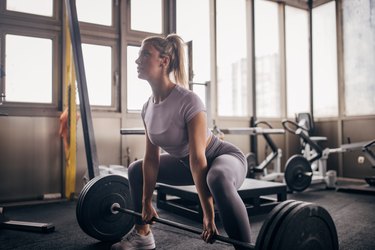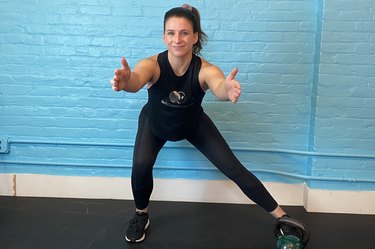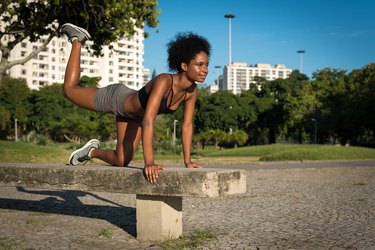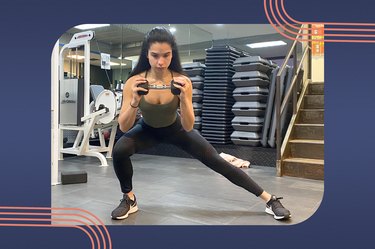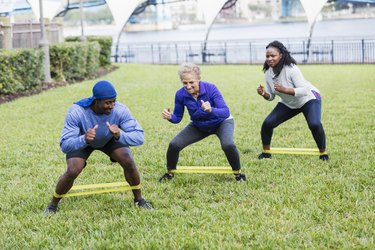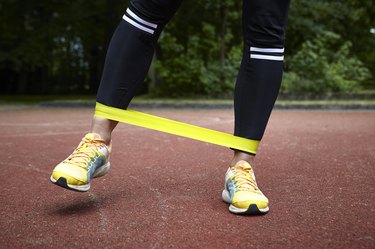
Squats and hip thrusts get plenty of attention for glute growth — and for good reason. But lateral band walks are the underrated move you absolutely must add to your lower-body routine.
- What is a lateral band walk? It's an exercise that involves stepping to the side with a mini band around your legs, explains Melissa Garcia, DPT, a Washington-based physical therapist.
- What muscles does the lateral band walk work? It mainly targets your glute muscles, and is one of the best glute medius exercises, Garcia says. (Your glute med makes up the side and top of your glutes.)
- Who can do this move? This all-levels-welcome exercise is safe for most people. Although it's recommended for those working on their hip, spine, knee or ankle stability, anyone with a previous injury should talk to their doctor before trying new exercises, Garcia says.
Video of the Day
In need of a mini band? These are our top picks:
- Fit Simplify Resistance Loop Exercise Bands (Amazon.com, $12.95)
- Haisea Resistance Bands (Amazon.com, $8.99)
- BERTER Resistance Bands (Amazon.com, $15.99)
How to Do the Lateral Band Walk with Perfect Form
This move is deceptively easy — meaning it looks way easier than it is. If you're doing a mini band lateral walk with good form, you should definitely feel some burn. And if not, you may want to re-assess your form in a mirror.
Lateral Band Walk
- Place a mini band around your ankles and stand with your feet hip-width apart.
- Slightly bend your knees and lower yourself a few inches into an "athletic stance."
- Step to your right side with your right foot.
- Step your left foot toward your right to return your feet to hip-width apart.
- Keeping your knees bent, take several steps to the right.
- Repeat this motion moving to the left.
Tip
If you're short on space, you can switch directions with each rep.
3 Lateral Band Walk Benefits
1. It Helps Prevent Injury
Strong glutes may help you squat heavier and run faster, but they also keep you injury-free. Your gluteus medius helps keep your hips and knees stable, which is a big part of injury prevention, says California-based trainer Carolina Araujo, CPT.
A strong gluteus medius can decrease your risk of lower-body injuries, aches and pains over time, she says. But considering most exercises or activities involve forward and backward (rather than side to side) motions, the glute med often doesn't get the attention it needs.
Lateral (side-to-side) exercises are perfect for preventing pain and strengthening this often-missed muscle.
2. It's a Great Warm-Up Move
Like clamshells, side band walks are a great way to activate your glute muscles before a workout, Araujo says. She suggests incorporating them into your dynamic warm-up routine.
Firing up your glutes before a hard workout ensures you're able to take full advantage of these muscles while you train, according to a July 2017 study in the BMJ Open Sport & Exercise Medicine. In the long run, this helps build more muscle while you exercise.
3. It Can Ease Lower Back Pain
Considering it's so helpful in stabilizing your hip joints, Garcia loves using this exercise to address lower back pain. By strengthening the glutes, you build pelvic stability, which helps reduce stress on your lower back.
However, always follow your doctor's or physical therapist's prescribed rehab routine before you mix in any new moves.
3 Must-Follow Lateral Band Walk Tips
1. Take Small, Slow Steps
The greater the step, the greater the results, right? In this case, not exactly.
When you take steps that are too big, you start to rely on momentum and your legs (rather than your hips) to do the move, which defeats the purpose. Chances are, your knees will start to cave in, too, causing your form to break down.
Tip
Watch yourself in a mirror. Your torso should stay straight up and down at all times. If you catch yourself leaning to the right or left, take smaller steps.
2. Point Your Knees and Toes Forward
This exercise should feel challenging, but you don't want to choose a band that hinders your form, Garcia says. If your knees or toes collapse or rotate inward as you step side to side, opt for a lighter band.
Tip
Watch yourself in the mirror to make sure your toes, knees and hips point forward as you do this move. Use a lighter resistance band if you notice your form starting to suffer.
3. Bend Your Knees
To get the most glute-building benefits out of this exercise, you want to stay in a semi-squat position, Araujo says.
Your thighs don't need to be completely parallel to the ground, but you want to keep a bend in your knees.
Tip
Stand in front of a mirror to make sure you hold your quarter-squat as you step side to side. If holding this position feels too difficult, Araujo recommends taking a few quick pauses to shake out your legs.
2 Band Walk Modifications
1. Around-the-Feet Band Walk
Putting the mini band around your feet is a little easier because it creates less resistance for your lower body to push against.
Around-the-Feet Band Walk
- Stand with your feet hip-width apart with a mini band around your feet.
- Slightly bend your knees and lower yourself a few inches into an "athletic stance."
- Step to your right side with your right foot.
- Step your left foot toward your right to return your feet to hip-width apart.
- Keeping your knees bent, take several steps to the right.
- Repeat this motion moving to the left.
2. Around-the-Thigh Band Walk
The banded ankle walk does place some side-to-side stress on your knees. So if you have any joint discomfort during the move, try placing the band around your thighs, just above your knees.
Around-the-Thigh Band Walk
- Place a mini band right above your knees and stand with your feet hip-width apart.
- Slightly bend your knees and lower yourself a few inches into an "athletic stance."
- Step to your right side with your right foot.
- Step your left foot toward your right to return your feet to hip-width apart.
- Keeping your knees bent, take several steps to the right.
- Repeat this motion moving to the left.
2 Band Walk Progressions
1. Double Band Walk
Using two bands instead of one adds more resistance, meaning your muscles have to work harder to step side to side.
Double Band Walk
- Place one mini resistance band right above your knees and another around your ankles. Stand with your feet hip-width apart.
- Slightly bend your knees and lower yourself a few inches into an "athletic stance."
- Step to your right side with your right foot.
- Step your left foot toward your right to return your feet to hip-width apart.
- Keeping your knees bent, take several steps to the right.
- Repeat this motion moving to the left.
2. Banded Lateral Squat Walk
Squatting lower to the ground with each step makes your glute (and even quad) muscles work harder as you walk side-to-side.
Banded Lateral Squat Walk
- Place a mini band around your ankles and stand with your feet hip-width apart.
- Bend your knees and lower until you're in a full squat.
- Step to your right side with your right foot.
- Step your left foot toward your right to return your feet to hip-width apart.
- Keeping your knees bent, take several steps to the right.
- Repeat this motion moving to the left.
Was this article helpful?
150 Characters Max
0/150
Thank you for sharing!
Thank you for your feedback!
